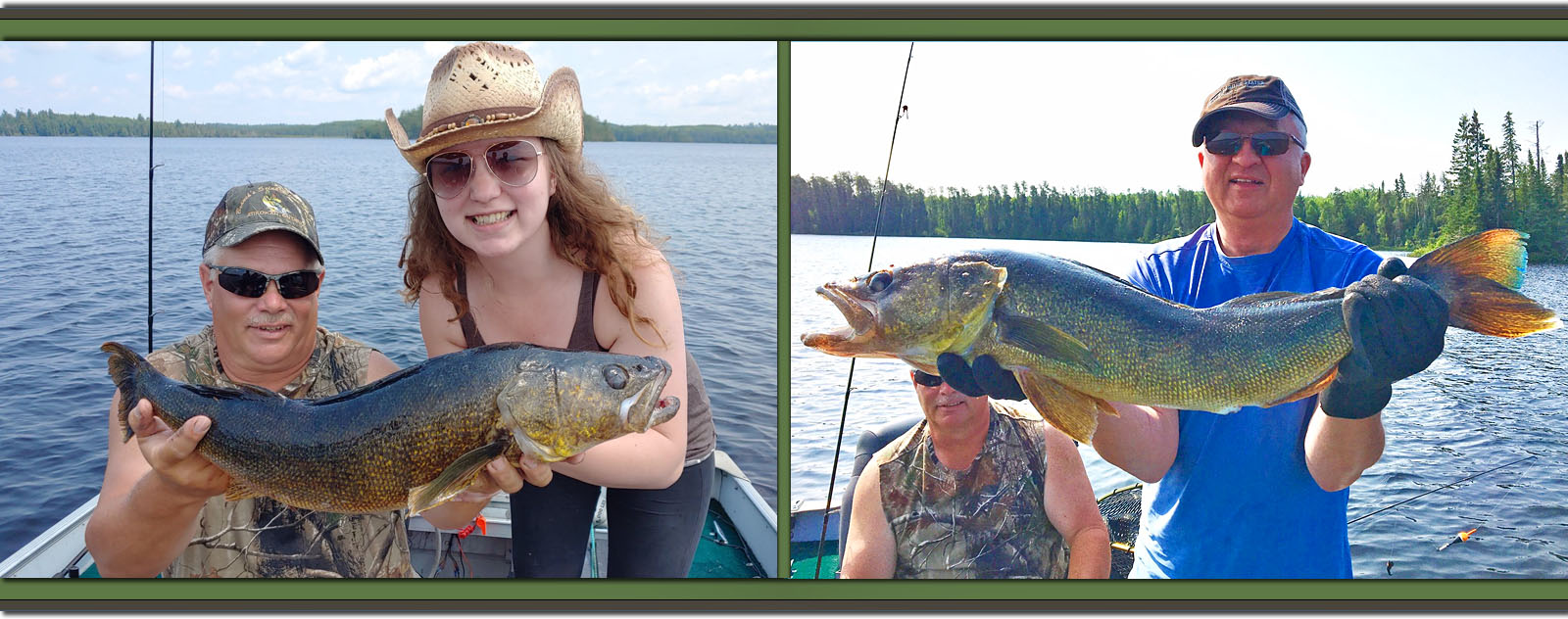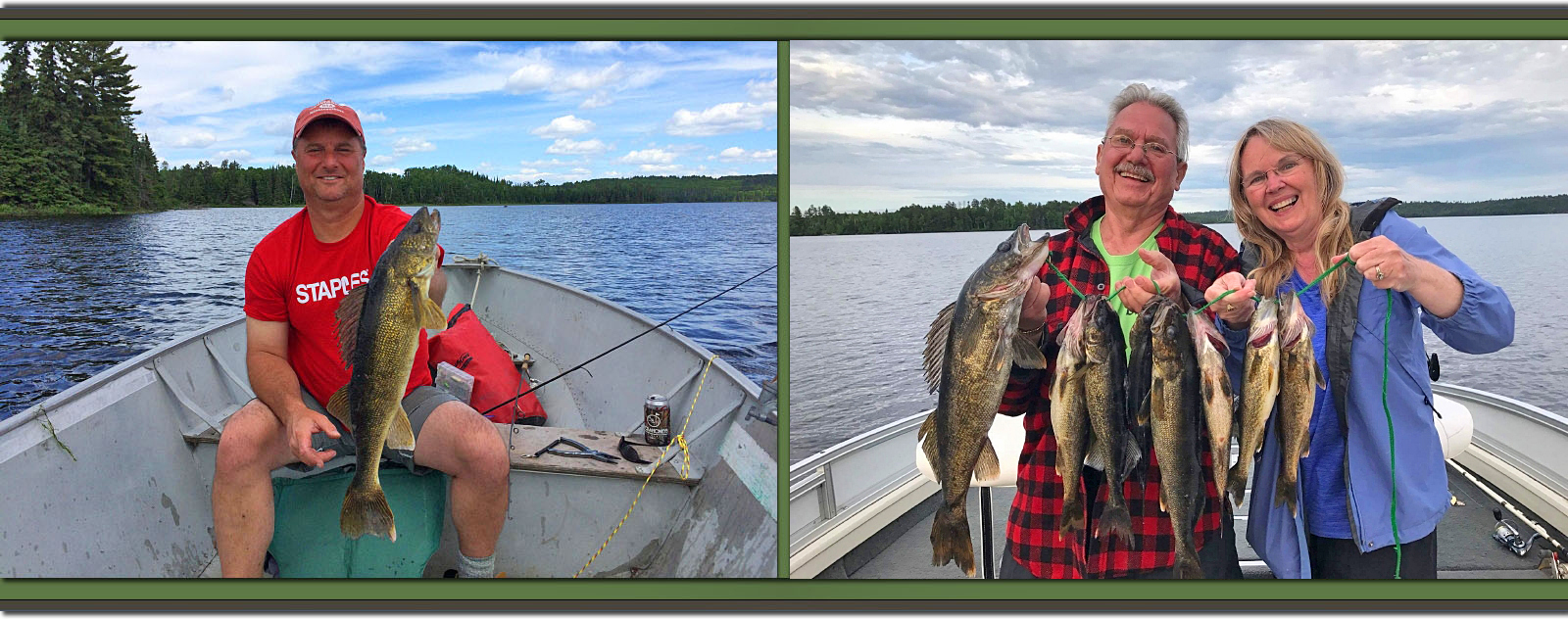



The Seine Chain Walleye:
The Seine Chain of Lakes offers an incredible array of walleye fishing opportunities throughout the system.
Aside from being able to access 30 miles of water and five lakes right from our dock, our pickerel anglers appreciate many other features of the Seine River System.
The water on the Seine is "rust". Many of our walleye anglers appreciate the stained water because they feel it enhances their fishing success at any time of day - even in the high sun.
Seine Chain Walleye Techniques:
The majority of people who fish walleye and do well with good numbers tend to favor live bait.
Vertical jigging with a leech, crawler or minnow, seems to offer the most action as far as numbers go. Jigs usually vary from 1/8 oz to 3/8 oz. Some use heavier - particularly in channels with current - but keep in mind that the bottom of our lakes is full of snags and you may spend a lot of time re-tying jigs when you use heavier weights.
Although all colors are used, the most popular colors by a long shot for jigs are white and chartreuse. Pink and blue follow with green and black .
Drop shotting is an incredibly effective way target 'eyes - not as common as a round head jig, but a great way to ensure you're in the zone (ie the bottom) while also minimizing snags
Although you'll hear lots of proponents of drifting while jigging, plan to anchor and do a lot of stationery jigging. Drifting works to a point, but the guys who do really well with numbers on this system tend to drop the anchor once they find the fish.
Another pointer - many of the "walleye holes" we fish, have been great walleye holes for the last 40 years, and long before that. They may not always be there, or they may not always be biting, but just because you don't get action when checking them out once or twice, don't cross them off your list. Keep checking them out - it's worth your while.
Although we don't encourage drifting on a regular basis over vertical jigging, when fishing in the current - mainly the narrows, we are big advocates of anchoring in a good walleye area, casting your line upstream & letting the current carry it back downstream. It is one of the best ways to get depth when fishing in current without using too heavy a weight and has resulted in some great walleye action for many anglers over the years.
When doing this, again, jigs with crawlers, minnows & leeches are the most popular as well as tackle like Little Joe
Nightcrawlers are often effective in any of the above scenarios as well, and worm harnesses work well, although crawlers seem to be more effective in the warmer months of the summer.
Depending on the time of year, weather and lake, depths vary. In the spring we often see a lot of shallow water action - sometimes as shallow as 7 - 8 feet and less.
In mid summer we often see walleyes in depths of 25', and if it's a hot year up to 35' - 40'. But don't discount weedy shallows during the heat,
We will advise you what depths have been the most active recently to help you narrow your focus. We will also point out good areas to start working. We don't just say - "There's the lake - good luck!".

Many of our guests favor trolling - usually back trolling - and this is a very successful technique. Trolling on our system does take some time to learn spots to work and technique.
Guests often use spinners - like Little Joes' - with # 8 or # 9 sinkers and usually minnows.
To a lesser extent, we have a number of groups that prefer using artificial baits to catch walleye.
Many of these groups cast or troll with plugs such as Rapalas, Mepps Spinners, Thundersticks etc.
These anglers tend to catch bigger fish on average, but unless you know the water it is a tough technique to be successful with.
Most of our groups who favor artificial have been fishing our waters for many years and work areas that they know to be tried and true.
It's certainly worth trying, but you're far better to take one of your spots where you've caught 'eyes by jigging, and work that specific area.
Otherwise you can burn a lot of precious time trolling aimlessly, perhaps over schools of walleye because the depths vary so much throughout the system, and begin to think there's no walleye at all.
The Walleye Fishery on the Seine Chain:
There are lots of walleye on the Chain, but they can be finicky and you have to be open minded.
For the most part we have a lot of "good eaters" - we've seen huge numbers of fish in the 12" - 18" range recently (the majority around 15"), quite a few 18" - 21", and some in the 22" - 25" range. They're there, they just are more elusive.
The good numbers and varied sizes - particularly the strong numbers of smaller 'eyes indicate to us a very healthy walleye fishery.
Of course each year we have the big ones in the 30" + range, but they are the exception and not the rule.
Our best advice is to go out, work hard, try different things

When fishing for walleye on our system, you need to get the jig or spinner down to the bottom and work it about a foot or so off the bottom. Or sometimes let it sit on the bottom and jig from there. Bottom bouncing works well, providing you have a spot and / or tackle that doesn't snag easily.
Many of our guests favour trolling. Trolling on our system does take some time to learn spots to work and technique, but some of our most consistent walleye
Guests often use spinners - like Little Joes' - with # 8 or # 9 sinkers and live bait.
To a lesser extent, we have a number of groups that prefer using artificial baits to catch walleye. But the ones that do count amongst our most successful and consistent walleye anglers. Trolling with artificial bait tends to produce less numbers than jigging in a school, but it's the best technique for larger fish.
Most these groups troll with plugs such as Rapalas, Thundersticks, Wally Divers etc.
We'll help with areas to target and techniques to use trolling for walleye.
When to Fish Walleye on the Seine Chain:
Walleye season opens the 3rd weekend in May and is open through the next April. Spring fishing - post spawn - sees the 'eyes scattered, often shallow and often near spawning areas.
By early July, the walleye have schooled and are in their summer holes. While depths vary, the schooling pattern tends to continue the rest of our season. Most are near the bottom of the lake, but you'll find suspended schools as well.
Although many of our regulars do well fishing all day, the most productive times still tend to be early a.m. through until around 10 or 11 and in the afternoon from about 4 until dark. The early bird often does get more walleye.
Wind direction tends to account for the most excuses for walleye not hitting, and while the prevailing NW wind is the nost popular, we've seen great action with most wind directions.

There are lots of walleye on the Chain, but they can be finicky and you have to be open minded.
For the most part we have a lot of "good eaters" - we've seen huge numbers of fish in the 12" - 18" range recently (the majority around 15"), quite a few 18" - 21", and some in the 22" - 25" range. They're there, they just are more elusive.
The good numbers and varied sizes - particularly the strong numbers of smaller 'eyes indicate to us a very healthy walleye fishery.
Of course each year we have the big ones in the 30" + range, but they are the exception and not the rule.
Our best advice is to go out, work hard, try different things.
Other Lakes With Great Walleye Fishing: Although most of our groups never leave the Seine Chain, there are literally dozens of nearby lakes where you can fish walleye.
They range from easy access with boat launches, to lakes that require portaging, canoes etc.
Some of our most popular daytrip walleye lakes are Ear Lake, Whelan Lake, Pipe Lake, Surprise Lake, Dovetail Lake and Marmion Lake / The Floodwaters amongst many others.
You'll be amazed by the water we can offer!

